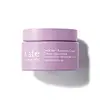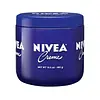What's inside
What's inside
 Key Ingredients
Key Ingredients

No key ingredients
 Benefits
Benefits

 Concerns
Concerns

 Ingredients Side-by-side
Ingredients Side-by-side

Water
Skin ConditioningGlycerin
HumectantTrimethylolpropane Tricaprylate/Tricaprate
EmollientPentaerythrityl Tetraisostearate
EmollientCoco-Caprylate/Caprate
EmollientPentaerythrityl Distearate
EmulsifyingCetearyl Alcohol
EmollientCaprylic/Capric Triglyceride
MaskingBis-Stearyl Dimethicone
EmollientPropanediol
SolventButyrospermum Parkii Butter
Skin ConditioningPentylene Glycol
Skin ConditioningHexyldecanol
EmollientGlyceryl Stearate
EmollientDimethicone
EmollientCeramide NP
Skin ConditioningMel
EmollientTetrapeptide-14
Skin ConditioningCeramide EOP
Skin ConditioningBoswellia Serrata Extract
Skin ConditioningPhytosphingosine
Skin ConditioningCeramide AP
Skin ConditioningCholesterol
EmollientCamellia Sinensis Leaf Extract
AntimicrobialGlycine Soja Seed Extract
Skin ConditioningOryza Sativa Bran Extract
Skin ConditioningEctoin
Skin ConditioningCetylhydroxyproline Palmitamide
Skin ConditioningBisabolol
MaskingCucumis Sativus Seed Oil
EmollientHydroxyectoin
BufferingHelianthus Annuus Seed Oil
EmollientAdenosine
Skin ConditioningTasmannia Lanceolata Fruit/Leaf Extract
AntioxidantSorbitan Isostearate
EmulsifyingStearic Acid
CleansingBrassica Campestris Sterols
EmollientTocopherol
AntioxidantRosmarinus Officinalis Leaf Extract
AntimicrobialZingiber Officinale Root Extract
MaskingAspalathus Linearis Extract
Skin ConditioningAminomethyl Propanol
BufferingHydroxyphenyl Propamidobenzoic Acid
Skin Conditioning1,2-Hexanediol
Skin ConditioningPEG-40 Stearate
EmulsifyingHydroxyethyl Acrylate/Sodium Acryloyldimethyl Taurate Copolymer
Emulsion StabilisingButylene Glycol
Humectant4-T-Butylcyclohexanol
MaskingIsohexadecane
EmollientPolysilicone-11
Ceteareth-20
CleansingSodium Lauroyl Lactylate
EmulsifyingCaprylhydroxamic Acid
Xanthan Gum
EmulsifyingPolysorbate 60
EmulsifyingTrisodium Ethylenediamine Disuccinate
Carbomer
Emulsion StabilisingCitric Acid
BufferingPhenoxyethanol
PreservativeSodium Benzoate
MaskingPotassium Sorbate
PreservativeWater, Glycerin, Trimethylolpropane Tricaprylate/Tricaprate, Pentaerythrityl Tetraisostearate, Coco-Caprylate/Caprate, Pentaerythrityl Distearate, Cetearyl Alcohol, Caprylic/Capric Triglyceride, Bis-Stearyl Dimethicone, Propanediol, Butyrospermum Parkii Butter, Pentylene Glycol, Hexyldecanol, Glyceryl Stearate, Dimethicone, Ceramide NP, Mel, Tetrapeptide-14, Ceramide EOP, Boswellia Serrata Extract, Phytosphingosine, Ceramide AP, Cholesterol, Camellia Sinensis Leaf Extract, Glycine Soja Seed Extract, Oryza Sativa Bran Extract, Ectoin, Cetylhydroxyproline Palmitamide, Bisabolol, Cucumis Sativus Seed Oil, Hydroxyectoin, Helianthus Annuus Seed Oil, Adenosine, Tasmannia Lanceolata Fruit/Leaf Extract, Sorbitan Isostearate, Stearic Acid, Brassica Campestris Sterols, Tocopherol, Rosmarinus Officinalis Leaf Extract, Zingiber Officinale Root Extract, Aspalathus Linearis Extract, Aminomethyl Propanol, Hydroxyphenyl Propamidobenzoic Acid, 1,2-Hexanediol, PEG-40 Stearate, Hydroxyethyl Acrylate/Sodium Acryloyldimethyl Taurate Copolymer, Butylene Glycol, 4-T-Butylcyclohexanol, Isohexadecane, Polysilicone-11, Ceteareth-20, Sodium Lauroyl Lactylate, Caprylhydroxamic Acid, Xanthan Gum, Polysorbate 60, Trisodium Ethylenediamine Disuccinate, Carbomer, Citric Acid, Phenoxyethanol, Sodium Benzoate, Potassium Sorbate
 Reviews
Reviews

Ingredients Explained
These ingredients are found in both products.
Ingredients higher up in an ingredient list are typically present in a larger amount.
Citric Acid is an alpha hydroxy acid (AHA) naturally found in citrus fruits like oranges, lemons, and limes.
Like other AHAs, citric acid can exfoliate skin by breaking down the bonds that hold dead skin cells together. This helps reveal smoother and brighter skin underneath.
However, this exfoliating effect only happens at high concentrations (20%) which can be hard to find in cosmetic products.
Due to this, citric acid is usually included in small amounts as a pH adjuster. This helps keep products slightly more acidic and compatible with skin's natural pH.
In skincare formulas, citric acid can:
While it can provide some skin benefits, research shows lactic acid and glycolic acid are generally more effective and less irritating exfoliants.
Most citric acid used in skincare today is made by fermenting sugars (usually from molasses). This synthetic version is identical to the natural citrus form but easier to stabilize and use in formulations.
Read more about some other popular AHA's here:
Learn more about Citric AcidGlycerin is already naturally found in your skin. It helps moisturize and protect your skin.
A study from 2016 found glycerin to be more effective as a humectant than AHAs and hyaluronic acid.
As a humectant, it helps the skin stay hydrated by pulling moisture to your skin. The low molecular weight of glycerin allows it to pull moisture into the deeper layers of your skin.
Hydrated skin improves your skin barrier; Your skin barrier helps protect against irritants and bacteria.
Glycerin has also been found to have antimicrobial and antiviral properties. Due to these properties, glycerin is often used in wound and burn treatments.
In cosmetics, glycerin is usually derived from plants such as soybean or palm. However, it can also be sourced from animals, such as tallow or animal fat.
This ingredient is organic, colorless, odorless, and non-toxic.
Glycerin is the name for this ingredient in American English. British English uses Glycerol/Glycerine.
Learn more about GlycerinWater. It's the most common cosmetic ingredient of all. You'll usually see it at the top of ingredient lists, meaning that it makes up the largest part of the product.
So why is it so popular? Water most often acts as a solvent - this means that it helps dissolve other ingredients into the formulation.
You'll also recognize water as that liquid we all need to stay alive. If you see this, drink a glass of water. Stay hydrated!
Learn more about Water